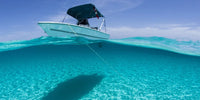
Anchoring 101: A Beginner’s Guide to Anchors and Docking Gear
, by Safe Water Team, 3 min reading time

, by Safe Water Team, 3 min reading time
Anchoring is a fundamental skill for any boater, whether you're fishing offshore, relaxing in a cove, or securing your boat overnight. However, improper anchoring can lead to drifting, collisions, or even grounding. This guide covers the basics every boater should know about choosing and using anchors and docking gear.
Understanding Anchors and Their Functions:
Types of Anchors:
Fluke (Danforth): Lightweight and ideal for sandy or muddy bottoms.
Plow (CQR/Delta): Versatile and good for variable seabeds.
Mushroom: Best for long-term anchoring in soft bottoms (often used for moorings).
Claw (Bruce): Easy to set and works well in most conditions.
Choosing the Right Size and Type:
Match the anchor size to your boat’s length and weight.
Consider local bottom conditions (sand, mud, rock, etc.).
Carry at least one backup anchor for emergencies or different seabeds.
Anchor Rode: Chain, Rope, or Both?
Rope-only: Lightweight and easier to store but less durable.
Chain-only: Provides better holding power but is heavier and harder to manage.
Combination (rope + chain): Offers strength and stretch; ideal for most recreational boats.
Essential Docking Gear and Techniques:
Dock Lines:
Use lines made of nylon for stretch and durability.
Include bow, stern, and spring lines for stability.
Inspect regularly for fraying and UV damage.
Fenders and Bumpers:
Protect your hull from impact at the dock.
Choose the right size and quantity based on your boat’s size.
Store them securely when not in use to avoid clutter.
Cleats and Chocks:
Ensure cleats are securely mounted.
Use chocks to guide lines and prevent chafing.
Tips for Successful Anchoring:
Approach slowly into the wind or current.
Lower (never throw) the anchor to avoid tangling.
Let out sufficient scope (typically 5:1 to 7:1 ratio of rode length to water depth).
Back down gently with the engine to set the anchor.
Monitor your position using GPS or visual bearings.
Conclusion:
Anchoring and docking may seem routine, but mastering these skills is crucial to your safety and vessel maintenance. Choosing the right type of anchor and using high-quality docking gear can mean the difference between a smooth outing and an expensive mishap. Always keep your gear in good condition, know your environment, and don’t rush the process. With practice and preparation, you’ll gain the confidence needed to secure your boat in almost any condition. Remember, safe anchoring is not just about equipment—it’s about experience, awareness, and respect for the water.